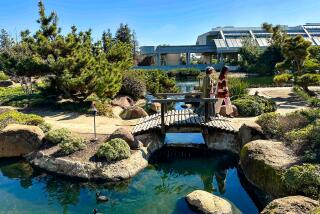Aruba’s Parched Playground
- Share via
ORANJESTAD, Aruba — I’d never given much thought to the term “desert island” until I visited Aruba.
Its arid, rumpled landscape bristles with long-armed cactuses, aloe plants and sad, spindly divi-divi trees bent low by the persistent winds. The key features of the interior of this Caribbean island are gigantic rock piles inhabited by wild goats, the remains of gold-mining operations, a few caves with ancient inscriptions and a massive stub of magnetic rock. In the last 24 years, the temperature here hasn’t dropped below 66 degrees, and as late as 1926, people on the island died of thirst. The north coast’s stony perimeter supports little more than wild donkeys, stray dogs, iguanas the size of cats and a rattlesnake species found only on Aruba. Candlestick cactuses are so abundant that householders build fences with them. Early Spanish settlers, not knowing what to make of this small, isolated and rocky place, dismissed Aruba as the islas inutiles, or “useless islands.”
Its very desert-ness has protected it. Although many of its more lush and populated Caribbean neighbors have suffered slavery, colonization, economic exploitation and mass tourism, Aruba, which is just 18 miles from Venezuela, has been left mostly alone. The island sports a pair of wide white-sand beaches on the southern coast, lined with up-market tourist hotels; a reasonably safe and sometimes charming capital city that reflects a bit of the island’s Dutch heritage and harbors some superb restaurants; and an efficient modern airport that can land big jets.
The northern coast, meanwhile, remains exotic, rocky desert, almost completely undeveloped and partly protected by national laws.
Aruba is a desert island with a great beach and comfortable resort hotels. Or, if you prefer, a pleasant resort island with a nearby desert playground. Either way, it’s a good place to combine the pleasures of a typical resort getaway with a little Discovery Channel-style stimulation. Add the fact that 70-square-mile Aruba stands safely outside the hurricane belt, and this arid, scrubby place starts to look quite “useful” indeed.
That’s not to say Aruba is undiscovered. Upward of 680,000 people visited Aruba last year, more than half of them Americans, and its 6,800 hotel rooms run about 77% capacity year-round. Our hotel, an 800-room, time-share beachfront behemoth called La Cabana, had a Dunkin’ Donuts in the pool courtyard right outside our patio, and from our front door I could see--past the parking lot and across from the miniature golf course--an Outback Steakhouse. The hotels have cable, the water is drinkable, and if you have no interest in native cuisine, you can eat at one of three Wendy’s, two Pizza Huts or a Tony Roma’s. Everything is in U.S. dollars. You’ll need plenty of them; nearly all the food is imported, so it’s hard to find a place where lunch entrees cost less than $10 or dinners less than $20.
O ur hotel complex featured three pools--one a huge polygonal affair, one with a swim-up cave, and one with a swim-up bar--and an unforgettable three-story water slide that propelled my body faster than it’s ever moved without benefit of a vehicle. Our boys, 9 and 10, spent hours on it. When they rested, they gave the iguanas the cherries from the tropical drinks that my wife, Pam, and I were sipping.
The usual resort activities--aqua aerobics, bingo, limbo--punctuated the days, and banana boats, sail boards and Jet Skis were never far from sight on the beach. In the resort’s casual outdoor restaurant, we ate Americanized meals and, one night, enjoyed an incredible show by the Ballet Folklorico Nacional di Aruba, with dances from the many cultures Aruba has absorbed over the centuries--South American, African, European and more.
But the highlight was the beach. La Cabana sits across three narrow lanes of access road from Eagle Beach, whose blue-green waves were perfect for low-impact body-surfing. Like many Caribbean islands, Aruba is rugged and inhospitable only on the side that faces the sea. The quiet side, in this case the southern coast where the hotels stand, is calm.
The beach in front of La Cabana is spotted with thatch-roofed huts and plenty of vinyl-webbed chairs. If the young men who set them up for us were seeking nothing more than a tip, it would have been pleasant. Unfortunately, some were real estate and water-sports pitchmen trying to cut day-trip snorkeling deals and extract time-share-visit commitments. In some ways, they were worse than the ganja dealers who prowl Jamaican beaches: The dope guys at least seem to know who the prospects are and stay away from others, but the time-share dudes approached everyone. Worse, the salesmen pressed a time-share brochure on us every time we passed through the lobby at La Cabana. Who wants this hassle on vacation?
If you’re just going to hang around the resorts, there’s no good reason to choose Aruba over more affordable islands. The payoff comes when you rent a four-wheel-drive (not a car) and tool around the north coast. Any number of outfitters offer four-wheel-drive “safaris,” but when we toured the island independently, we saw many lines of vehicles 20 or 30 long, creating traffic jams and crowds at each attraction.
Many guidebooks tell you that you can tour the island, which is 19 1/2 miles long and six miles wide, in half a day--a day if you take a picnic lunch. What a hoot. My family and I spent three hours one hot afternoon exploring Aruba’s delightfully mystifying interior roads (in a four-wheel-drive Samurai, no air-conditioning) trying to find just one much-touted attraction, something called the Natural Pool. As far as I could tell, no matter where you are in Aruba, the Natural Pool is “straight ahead and on the left.” At least that’s what the many friendly, helpful residents told us when we stopped to ask directions.
Though the roads were mostly unpaved and unmarked, we had a fine time. At one point, when we were hopelessly lost, I steered the Samurai down a savage little rut with no apparent exit. While I tried to turn the jeep around without tipping it, Pam and the kids wandered off and saw a small flock of green parrots in the trees, one of the great natural highlights of the trip. Soon a man with a cap and a cane walked slowly up to our jeep, perhaps to tell us we were on his property. I asked him how to get to Natural Pool, and it became clear he was mute. He lifted his cane and pointed: straight ahead and to the left.
B eginning at the lighthouse on the island’s western tip, a network of dirt roads skims the dramatic north coast, and vistas are inspiring. The coast is littered with rumbling dunes and giant boulders. In many places it is eroded into dramatic rock formations, and the waves explode vertically like geysers, misting everything with a fine, damp salt.
One site is particularly noteworthy: the ruins of the Bushiribana gold-stamping plant. Like many who see them for the first time, we thought they were the wreck of some castle or defense structure. The Bushiribana site processed gold in the 19th century but ceased operations after 10 years. Gold, however, continued to be mined until the early 20th century. Now, mercifully uninterpreted--there’s not a single historical marker or explanatory panel--the ruin makes a wistful stopover during a north coast tour.
I’d allow three half-days for a good sampling of Aruba’s charms: a climb of the 541-foot Hooiberg mountain; a pause at the Alto Vista Chapel, a meditation spot overlooking the coastal expanse; a walk along the Natural Bridge (one of about six on the island); a visit to the Ayo Rock Formations; quick ducks into the Guadirikiri Caves and Tunnel of Love, with its heart-shaped entrance; and a drive into the remote eastern coast beyond the belching oil refinery, where you’ll find the tame Baby Beach, plus stop at the refreshment stands along the road. Arubans are pleasant, and few live in the sort of squalor that makes you feel sick and wicked while touring other less affluent islands. The native roadside food is a delight, reflecting cultural traditions from Europe (blood sausages) and the island’s many ethnic groups (pastechi, a sort of meat pie turnover, the tastiest of which are stuffed with chop suey). Polar Beer, a Venezuelan import, is served in cute 8-ounce cans. An Aruban afternoon with a Polar and a ceiling fan overhead is a quiet pleasure.
It’s a stretch to argue that Aruba is distinctive because of its Dutch heritage, which it shares with neighbors Curacao and Bonaire. There are a couple of colonial-era attractions. Ft. Zoutman and Museum in downtown Oranjestad is the one must-see. But the charmingly shabby town, named after Holland’s royal House of Orange, has lately been fitted with a glitzy false front facing the cruise ships that dock daily and spill their thousands into town. Seaport Mall features a McDonald’s and Benetton, Hugo Boss, Nautica, a Nike shop and Aruba Sonesta Resorts, the island’s poshest hotel (with a private offshore island, accessible via a boat that meets you inside the lobby) and swankiest casino.
At the Seaport Mall, a display features one white Bengal tiger--among only 38 in the world, according to a sign encouraging visitors to stop. The idea of importing endangered beasts that have no connection to the island’s history or culture or environment illustrates precisely the sort of commercial indiscretion that, if widely adopted, will ruin Aruba.
By offering fine beach resorts and a desert landscape full of natural attractions grand and subtle, Aruba still is a refreshing, distinctive, comfortable place to vacation. If ever the north coast--that wonderful desert--falls into the hands of the people who brought in the white tiger, there no longer will be a reason to choose Aruba over any number of sunny places.
(BEGIN TEXT OF INFOBOX / INFOGRAPHIC)
GUIDEBOOK
Hitting the Beach in Aruba
Getting there: Connecting service is available on American, Continental, TWA, Delta and Avianca. Restricted round-trip air fares begin at $684.
Where to stay: Your key choice is between the high-rise hotels on Palm Beach or the low-rises on Eagle Beach. In terms of beach, Eagle has the clear advantage and far more elbowroom. Palm’s beaches are narrow, with more people spread out on them. Both beaches offer moderate ($175 per night, high season) to high ($200 plus) to really high prices ($300-$500), so the choice is more personal style than price.
We chose the 800-room La Cabana, telephone (800) 835- 7193 or 011-297-879-000, fax 011-297-870-844, Internet https://www.lacabana.com, on Eagle Beach because it is full of family-friendly amenities, including three pools, a big beach and in-suite kitchens, and was reasonable at $165 nightly in early high season (the week before Christmas). Our biggest complaint was the constant hassling by time-share shills.
Based on brief inspections of other properties, if money is no object, go for the Radisson, tel. (800) 333-3333 or 011-297-866- 555, fax 011-297-863-260, Internet https://www.radisson.com, which has upgraded and reopened; the Marriott, tel. (800) 223-6388 or 011-297-869-000, fax 011-297-860-649, Internet https://www.marriott.com; or the Hyatt, tel. (800) 233-1234 or 011-297-861-234, fax 011-297- 861-682, Internet https://www.hyatt.com. All have pools, casinos and nice Palm Beach sites.
At the value end, consider Bucuti Beach at Eagle Beach, tel. (800) 223-1108 or 011-297-836- 141, fax 011-297-825-272, Internet https://www.bucuti.com; or the Holiday Inn at Palm Beach, tel. (800) 465-4329 or 011-297- 863-600, fax 011-297-863-478, Internet https://www.basshotels .com/holiday-inn, recently refurbished but still dowdy.
Where to eat: Everything’s expensive. Even hot dogs go for $3.50 at snack stands. You can stretch your meal money with trips to grocery stores (along the strip connecting Oranjestad and the resorts) or fast food, expensive by U.S. standards but cheap by Aruba rates. Local restaurants in the island’s interior charge less than those catering to tourists near the resorts. A few distinctive restaurants:
Driftwood, local tel. 32-515: The owner goes fishing every day and serves his special catch in the evening.
Boonoonoonoos, tel. 31-888: This small, French Caribbean-themed place has a superb chef. We had wonderful curried goat and a chicken casserole in hollowed Gouda cheese.
Cuba’s Cookin’, tel. 80-627: This new, tony Cuban-style restaurant has tasty chicken soup, pork and chicken specialties.
El Gaucho, tel.23-677: This is a genuine Argentine beef house with extraordinary steaks shipped in from South America.
Pirate’s Nest, tel. 31-100: It has middling food but a romantic, campy, beached-pirate-ship environment facing the beach.
Fisherman’s Hut: On Palm Beach, it’s a little shack with a few tables serving fresh catch, usually about $6. It’s one of the island’s great dining values.
For more information: Aruba Tourism Authority, 1000 Harbor Blvd., Weehawken, NJ 07087; tel. (800) 862-7822 (TO-ARUBA) or (201) 330-0800, fax (201) 330- 8757, Internet https://www.aruba.com.
More to Read
Sign up for The Wild
We’ll help you find the best places to hike, bike and run, as well as the perfect silent spots for meditation and yoga.
You may occasionally receive promotional content from the Los Angeles Times.






